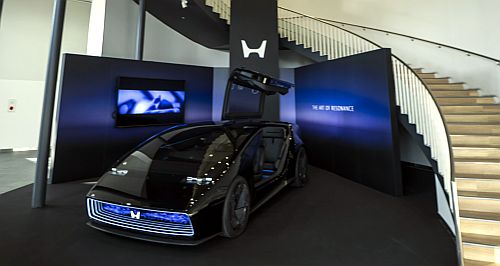Honda talks ‘thin, light, wise’ BEVs
BY MIKE STEVENS | 11th Oct 2024

HONDA is finally ready to show the critics its cards, revealing details of the battery electric vehicles (BEV) it will roll out from 2026 – with a goal of bringing 30 BEVs to market globally by 2030 – promising the holy trinity of electrification: a lightweight body, plenty of interior space and driving range to spare.
Until now, the company’s modern offering in the BEV space has been limited to the expensive, short-range E hatch and HR-V based E:NY1 for Europe, along with the bigger and further-driving Prologue SUV developed during a short-lived partnership with General Motors in North America.
During the recent Honda 0 Tech Meeting 2024 in Tokyo, the company introduced its vision for electric mobility, beginning in 2026 with a BEV range dubbed 0 Series under development on a new platform designed around the concepts of “Thin, Light, and Wise” with the next 0 Series model unveiling scheduled for January’s Consumer Electronics Show in Las Vegas.
This approach focuses on achieving high efficiency, sporty driving and maximised cabin space by using a compact and lightweight design, as well as an ambitious goal of keeping battery capacity degradation to less than 10 per cent after 10 years of use.
Core to this recipe, Honda says, is a new ultra-high-strength steel platform combined with a thin battery pack and a compact e-Axle, allowing for a low centre of gravity and the driving dynamics that come with it.
Honda also claims its low-slung design and compact components enables greater interior space, targeting a balance between performance and comfort.
Another topic at the event was Honda’s active aerodynamic system, which deploys a front aero deflector that adjusts according to vehicle speed, reducing drag to improve both efficiency and straight-line stability. Honda claims this will be especially effective for models with higher profiles, such as SUVs, which typically suffer from greater air resistance.
At this early stage, it remains to be seen just how far forward Honda is pushing the game with these efficiency advancements – the sort claimed by every brand, in the same song-and-dance style.
Finally, the batteries, again promised to be a main pillar of Honda’s Thin, Light, and Wise strategy. The company is “striving to limit” battery capacity degradation to under 10 per cent after 10 years of use. This is perhaps the boldest of Honda’s promises, with few brands willing to stand behind an ‘under 10 per cent’ target.
Hyundai and Kia, among the leaders in BEV technology, promise at least 70 per cent retention over 10 years (implying less than 30 per cent degradation). Tesla makes no claims, although data published by Electrek points to less than 10 per cent degradation over 270,000km of driving.
Along with Honda’s ambitious claims on capacity retention, its new thin battery pack should also be lighter. The company says its design incorporates 6000-ton megacasting and 3D friction stir welding, allowing – according to Honda – for a six per cent reduction in thickness while enabling a larger battery capacity for extended range without adding significant weight.
The “Wise” piece of Honda’s BEV plan centres on its approach to software and over-the-air (OTA) updates, ensuring that features like driver assistance systems, infotainment, and even battery management can be continuously improved post-purchase.
Again, these are systems many brands offer with their BEVs, but there is plenty of room to lead the market on the frequency and quality of the downloadable improvements.
Honda’s Level 3 automated driving capabilities will also feature in the 0 Series line, which should help the new models compete with the numerous brands rolling out the higher levels of automation.
The company did not reveal any details for the specific capacity and anticipated efficiency or driving range of its new batteries and models, although these are likely still in a very early stage of development and testing.
So far, Honda’s electrification journey has been tumultuous. Production of the charismatic E ended in January with just under 13,000 sales over three years, while big discounts on the more affordably built E:NY1 have helped to make it popular in the UK – although reports overseas suggest it performs poorly on efficiency.
The well-regarded Prologue SUV, like the E hatch, is now an orphan, with the GM-Honda partnership that birthed it having ended just months before launch.
Critically, none of those models were ever planned for Australia, leaving local leadership to talk about hybrids being the right level of electrification for Aussie motorists.
That will change by 2028, the brand has promised previously, and there has been increasing noise from Honda HQ over the past year – including the January unveiling of a very sleek, Odyssey-like ‘0 Series’ concept, and confirmation in May that the original H brand will pour a huge $A97 billion into BEVs over the next 10 years.
Honda’s CES exhibit should be one to watch come the New Year.